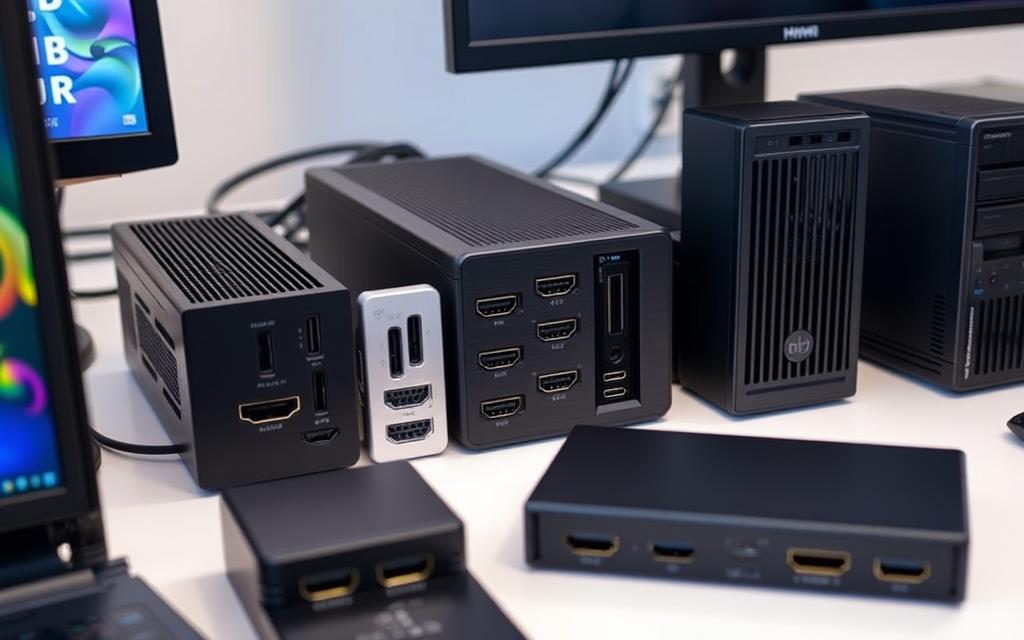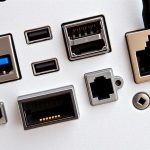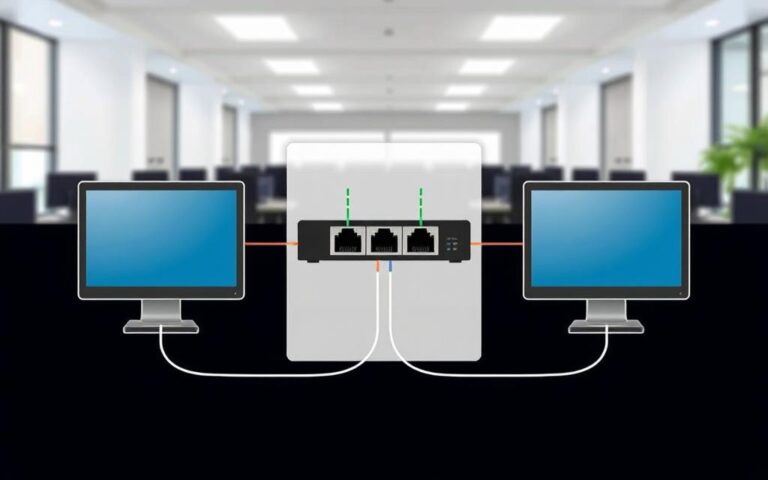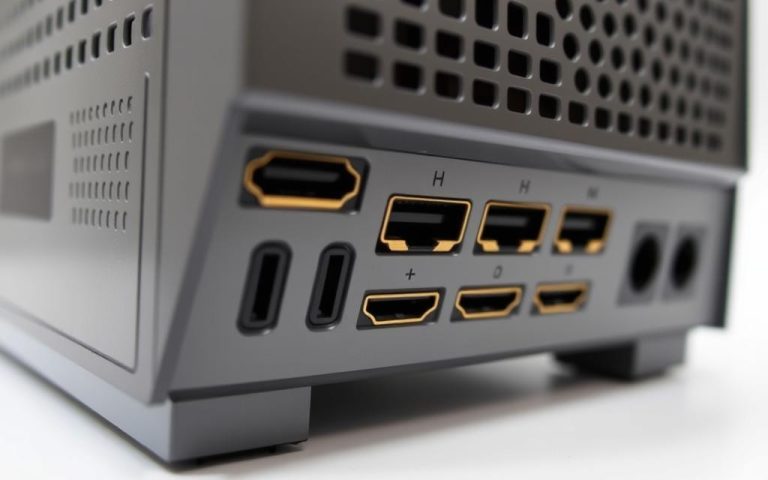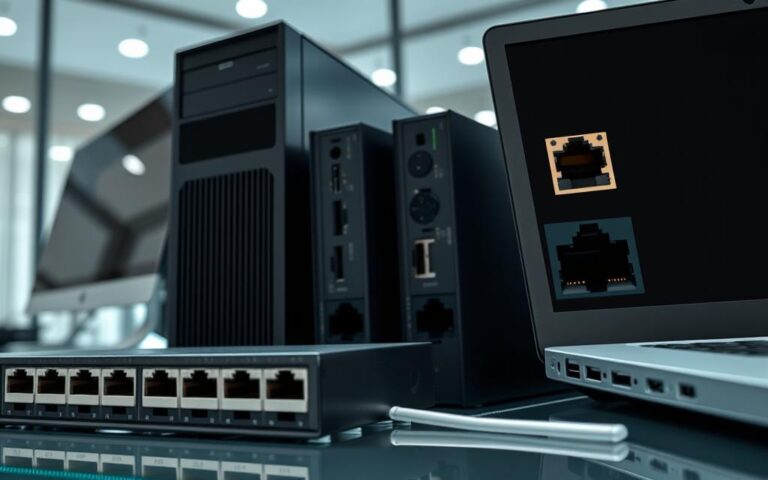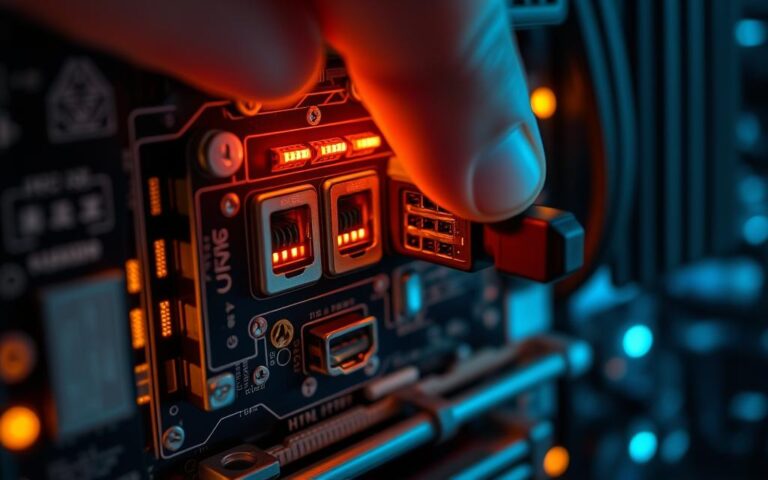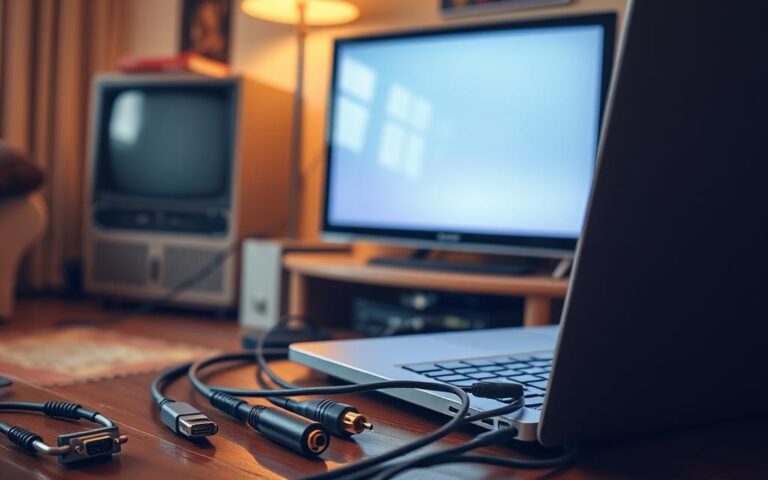HDMI Port Availability on Computers
Understanding HDMI port availability on computers is key for those needing high-definition connections. HDMI, or High-Definition Multimedia Interface, carries video and audio digitally, making user experiences better. But, remember, about 90% of older desktop computers lack HDMI ports. This might mean you need an upgrade or an adapter to connect to modern screens.
As HD content becomes more popular, people are finding different ways to use HDMI connections. HDMI cards are great for live streaming or capturing games. They come in internal versions for low latency and high performance. If your computer can’t take another card, external HDMI cards through USB or Thunderbolt are a good choice. They don’t need you to open your computer.
Adding a graphics card for less than £50 lets users upgrade their computer for HDMI support. There are different HDMI port types, including Standard (Type A), Mini (Type C), and Micro (Type D). This variety means more flexibility for various devices. Knowing about these options helps people make smart choices about their computer setups and HDMI use.
Understanding HDMI Technology
Understanding HDMI technology is crucial if you want to get the best out of your digital setups. HDMI, which stands for High-Definition Multimedia Interface, offers a way to send high-quality audio and video through just one cable. It’s used in many devices, from TVs to game consoles, making it important for modern tech.
What is HDMI?
HDMI is key for high-definition content. It supports video formats like 4K and 1080p, making it better than old connectors such as VGA. HDMI is not just convenient, it also gives top-notch audio-visual quality. This one cable makes everything simpler, doing away with the need for many cables. HDMI’s ability to handle both sound and picture has made it very popular, with nearly 10 billion units sold.
The Importance of HDMI Connections
HDMI is now the main standard for HDTVs. Around 90% of digital TVs had HDMI ports by 2007. Today, over 1,700 companies back HDMI tech, showing its versatility and dependability. HDMI makes streaming high-definition content easy, perfect for games, films, and video calls.
New HDMI versions, like HDMI 2.1, push for greater speed and performance. They offer features such as 8K video at 120Hz. These updates highlight HDMI’s role in ensuring a flawless viewing experience. The vast number of devices that use HDMI shows its key place in our digital world.
To learn more about HDMI technology and what it offers, check out this resource on what is HDMI.
Do Computers Have HDMI Ports?
Do different computers come with HDMI ports? This is important for people to check. Most new desktops and laptops have these ports, making it easy to link them with HD screens and TVs. This helps improve the quality of videos and images greatly. On the other hand, older computers might not have HDMI. Instead, they use VGA or DVI connections that can’t send HDMI signals.
Examining Different Computer Models
It’s key to look at your computer’s specs to see if it has an HDMI port. Many modern laptops have one, but some cheaper models may not. If your computer lacks HDMI, you might need a computer HDMI check. For those without it, USB-to-HDMI adapters are an option. These need extra software to work, though.
Identifying HDMI Ports on Your Computer
Finding HDMI ports on your computer is easy. Just look for a rectangular slot with 19 pins on the motherboard or on the side. If you’re not sure, check the manufacturer’s guide. For more details, look at desktop computer ports. Remember, if your computer has VGA or DVI instead, you might still need an adapter for HDMI devices.

Upgrading Your Computer for HDMI Support
Boosting your computer’s HDMI support can take your multimedia to the next level. Whether it’s adding an HDMI port to a desktop or laptop, the process is straightforward. It’s crucial to know which components fit your setup best.
Options for Adding an HDMI Port
For desktops, a great option is to install a new graphics card that has HDMI. Most PCs have basic video graphics, but adding a PCI Express x16 graphic card is easy. With less than £50, you can get a card that’s much better than the basic ones.
Look for cards offering different features:
- 4K HDMI Cards: Great for ultra-high definition video streaming and capture.
- 1080p HDMI Cards: Ideal for high-definition streaming and recording.
- Multi-Input HDMI Cards: They let you capture video from many sources at once.
Adding a graphics card is easy and has just four steps. You open up the computer, put in the new card, close it up, and set up the software. This way, you don’t have to buy a new computer for an upgrade.
Installing a New Graphics Card
Putting in a new graphics card is simple if you’re careful. Turn off your computer and take off the cover. Find the right slot, put in the card securely, then put the cover back and start your computer. The final step is to install the latest drivers for HDMI to work.
Laptops are a bit trickier to upgrade due to less space. HDMI adapters are the solution for enhancing your laptop’s HDMI. This improves how you stream videos to modern screens.
Utilising Adapters for HDMI Connections
When there’s no direct HDMI output, HDMI adapters are a must for smooth connections. These adapters help connect old equipment to new screens. This keeps old devices useful, adding to their performance.
Types of Adapters Available
There are many HDMI adapters to fit different needs. Here’s a look at some common ones:
- VGA to HDMI Converters: Convert analog VGA signals to digital HDMI. This lets you link old computers to new HDMI screens.
- DVI to HDMI Adapters: Perfect for connecting DVI output devices to HDMI screens. It ensures devices can work together despite different connections.
- USB-to-HDMI Adapters: A way to add HDMI ports to devices without them. It makes using laptops and desktops easier.
- Wireless HDMI Transmitter and Receiver Systems: These provide flexibility, letting users stream to HDTVs or projectors without wires.
How to Use Adapters for HDMI Output
Connecting HDMI outputs with adapters is easy. Just follow these steps for a good experience:
- Find the right port on your computer (VGA, DVI, or USB) and link it to the HDMI adapter.
- For VGA adapters, you might need an extra audio cable to carry sound.
- Then, plug an HDMI cable from the adapter to the screen.
- Turn on the converter and choose the correct input on your display.
- Your screen should now display the output with no issues.
This method lets people with older tech enjoy high-definition content. It avoids the cost of new upgrades or big changes to hardware.
| Type of Adapter | Connection Type | Usage Purpose |
|---|---|---|
| VGA to HDMI | VGA (analog) to HDMI (digital) | Connects old PCs to HDMI displays; |
| DVI to HDMI | DVI to HDMI | Links DVI devices with HDMI ports; |
| USB-to-HDMI | USB to HDMI | Enables HDMI connectivity on older devices; |
| Wireless HDMI | Wireless | Streams video content without cables; |
Conclusion
Knowing about HDMI ports on computers is crucial for enhancing your multimedia fun. HDMI tech has grown a lot since it started. Now, it can support super high-quality images, up to 8K. As we want more from our media, having devices that work well together is key. This makes HDMI very important for today’s computers.
Many new computers have HDMI ports, but older ones might need an upgrade to get high-definition quality. You can add new graphics cards or use adapters to improve connection. Also, knowing what each HDMI port can do helps get the best quality. This is especially true for gaming or video editing.
In the end, knowing about HDMI ports helps make your computer better. If you’re upgrading or fixing an HDMI problem, understanding their role is the first step. Looking into ways to improve and making sure everything is set up right can boost your computer’s power. This lets you connect easily to the latest screens and enjoy top-notch content.
FAQ
What is HDMI?
HDMI stands for High-Definition Multimedia Interface. It lets you send high-quality audio and video through one cable. It’s widely used in gadgets like TVs and game consoles.
Do all computers have HDMI ports?
Not every computer comes with an HDMI port. Older ones might use VGA or DVI instead. But, most new computers do have HDMI. This makes connecting to modern screens much easier.
How can I check if my computer has an HDMI port?
Look closely at your computer’s side or back to find an HDMI port. It’s a small, rectangular slot with 19 pins. For more details, you can always look at what the maker mentions or the user guide.
What should I do if my computer does not have an HDMI port?
If there’s no HDMI port, don’t worry. You can use adapters, like VGA to HDMI or DVI to HDMI. These let you hook up to HDMI screens. So, older PCs can still enjoy great video quality.
How can I upgrade my computer to support HDMI?
To add HDMI, you may need a new graphics card that has HDMI. Upgrading is generally easy. Just open up your PC, slot in the card, and install any drivers needed.
What types of HDMI adapters are available?
You can find adapters like VGA to HDMI for turning analog into digital. Or DVI to HDMI, for connecting DVI outputs to HDMI screens. These are handy for mixing old and new tech.
How do I use an HDMI adapter?
Using an HDMI adapter is simple. Connect it from your PC’s VGA or DVI port to the adapter. Then, link an HDMI cable from the adapter to your screen. Now, turn the converter on and enjoy your HD content on any display.

